AUDI TT ROADSTER 2018 Owners Manual
Manufacturer: AUDI, Model Year: 2018, Model line: TT ROADSTER, Model: AUDI TT ROADSTER 2018Pages: 310, PDF Size: 46.95 MB
Page 211 of 310
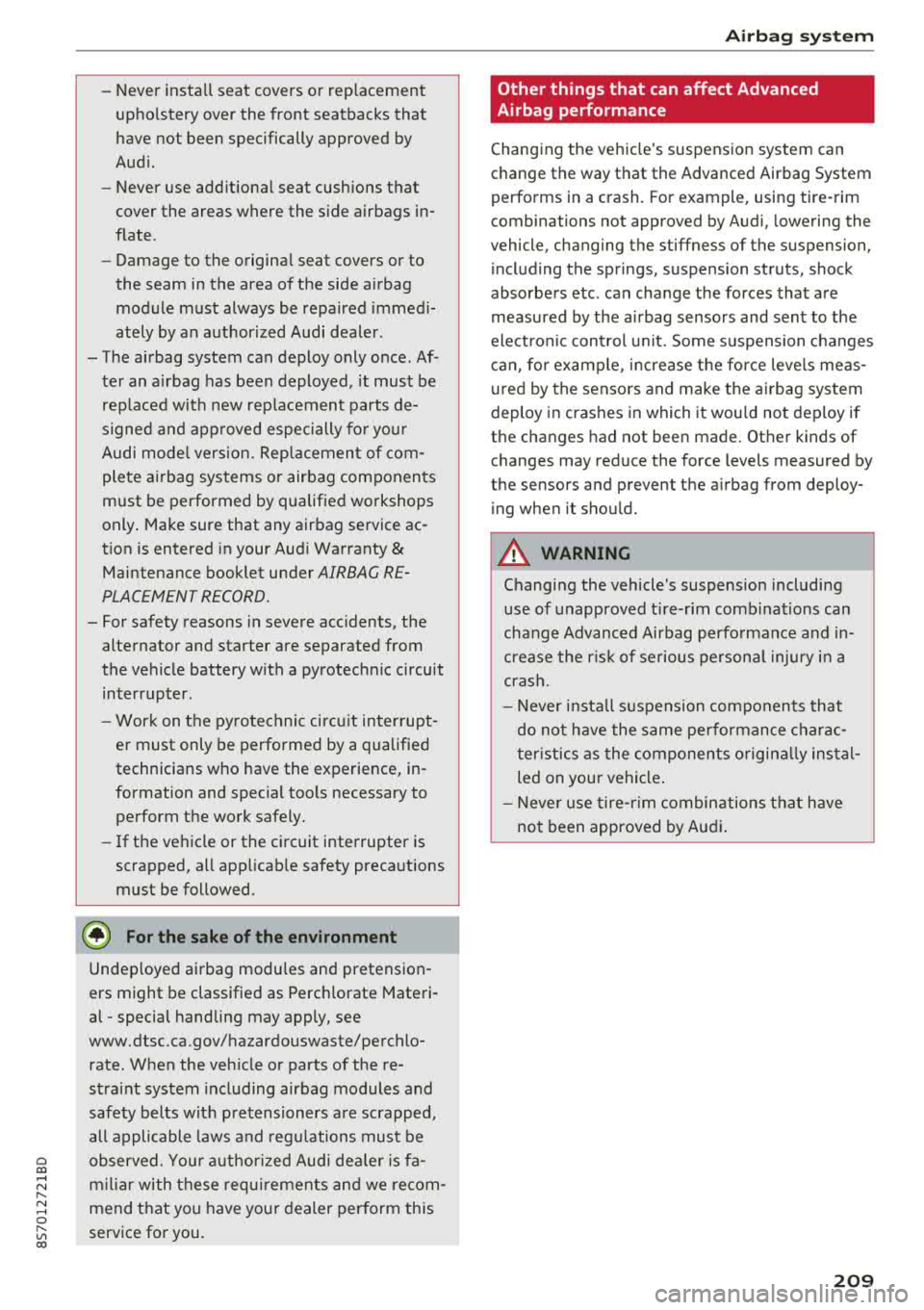
Cl 00 .-< N r-N .-< 0 r-Vl 00
-Never install seat covers or replacement
upholstery over the front seatbacks that
have not been specifically approved by
Aud i.
- Never use add itiona l seat cushions that
cover the areas where the s ide airbags in
flate.
- Damage to the origina l seat covers or to
the seam in the area of the side airbag module must always be repaired immedi
ately by an authorized Audi dealer.
- The airbag system can deploy only once . Af
ter an airbag has been deployed, it must be
rep laced with new rep lacement parts de
signed and approved especially fo r you r
Audi mode l version. Replacement of com
plete airbag systems or airbag components
must be performed by qualified workshops
only . Make sure that any airbag service ac
tion is entered in your Audi Warranty
&
Maintenance booklet under AIRBAG RE
PLACEMENT RECORD.
- For safety reasons in severe accidents, the
alternator and starter are separated from
the vehicle battery with a pyrotechn ic circuit
interrupter.
-Work on the pyrotechnic circu it interrupt
er must only be performed by a qualified
technicians who have the experience, in
formation and special tools necessary to perform the work safely.
-If the vehicle or the circuit interrupter is
scrapped, all app licab le safety precautions
must be followed.
@ For the sake of the environment
Undep loyed airbag modu les and pretension
ers might be classified as Perch lorate Materi
al
-special handling may apply, see
www.dtsc.ca.gov/hazardouswaste/perchlo
rate . When the veh icle or parts of the re
straint system including airbag modules and
safety belts with p retensioners are scrapped,
all appli cable laws and regulations must be
observed. Your authorized Audi dealer is fa
m il iar with these requi rements and we re com
mend that you have you r dealer per form this
service for you.
Airbag syste m
Other things that can affect Advanced
Airbag performance
Changing the vehicle's suspension system can
change the way that the Advanced Airbag System
performs in a crash. For example, using tire-rim
combinations not approved by Audi, lowering the
vehicle, changing the stiffness of the suspension, including the springs, suspension struts, shock
absorbers etc . can change the forces that are
measured by the airbag sensors and sent to the
electronic cont rol u nit. Some suspension c hanges
can, for example, increase the fo rce leve ls meas
u red by the sensors and make t he a irbag system
deploy in crashes in which it wou ld not deploy if
the changes had not been made. Other kinds of
changes may reduce the force levels measured by
the sensors and prevent the a irbag from deploy
ing when it should.
A WARNING
-
Changing the vehicle's suspension including use of unapproved tire-rim combinations can
change Advanced Airbag perfo rmance and in
crease the risk of serious personal injury in a
crash.
- Never install suspension components that
do not have the same performance charac
ter istics as the components o riginally instal
led on your vehicle .
-Never use tire-rim combin ations that have
not been approved by Audi .
209
Page 212 of 310
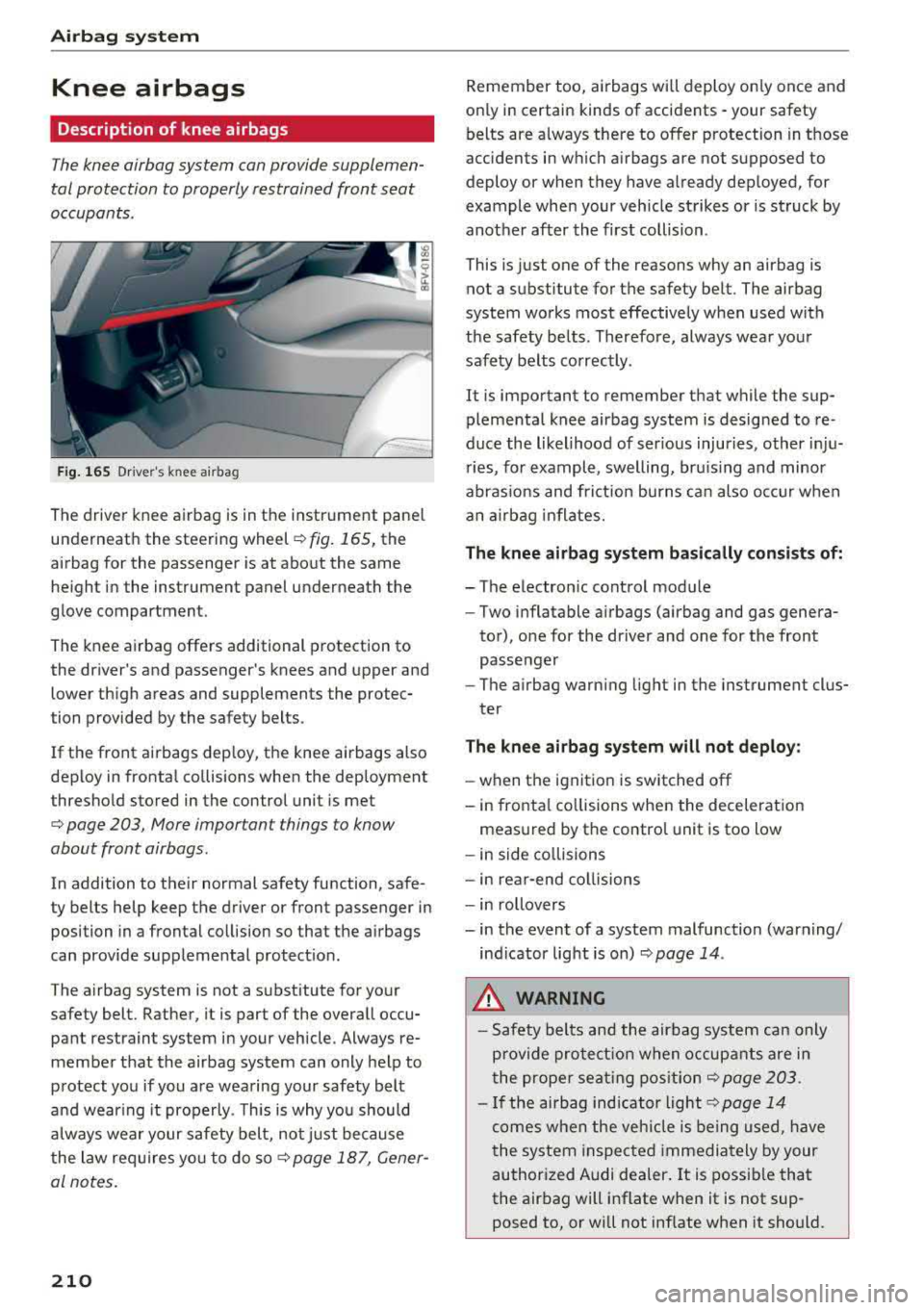
Airbag system
Knee airbags
Description of knee airbags
The knee airbag system can provide supplemen
tal protection to properly restrained front seat
occupants .
Fig. 165 Driver's k nee a irbag
The driver knee airbag is in the instrument panel
underneath the steering
wheel ¢ fig. 165, the
airbag for the passenger is at about the same
height in the instrument panel underneath the
glove compartment.
The knee airbag offers additional protection to
the driver's and passenger's knees and upper and
lower thigh areas and supplements the protec
tion provided by the safety belts.
If the front airbags deploy, the knee airbags also
deploy in frontal collisions when the deployment
threshold stored in the control unit is met
¢ page 203, More important things to know
about front airbags.
In addition to their normal safety function, safe
ty belts help keep the driver or front passenger in
posi tion in a frontal collision so that the airbags
can prov ide supplemental protection .
The airbag system is not a substitute for your safety belt. Rather, it is part of the overall occu
pant restraint system in your vehicle. Always re
member that the airbag system can only help to
protect you if you are wearing your safety belt
and wearing it properly . T his is why you should
always wear your safety belt, not just because
the law requires yo u to do so ¢
page 187, Gener
al notes.
210
Remember too, airbags will deploy only once and
on ly in certain kinds of accidents -your safety
belts are always there to offer protection in those
accidents in which airbags are not supposed to
deploy or when they have already deployed, for
example when your vehicle strikes or is struck by
another after the first collision .
This is just one of the reasons why an airbag is
not a substitute for the safety belt . The airbag
system works most effectively when used with
the safety belts. Therefore, always wear your
safety belts correctly.
It is important to remember that while the sup
plemental knee airbag system is designed to re
duce the likelihood of serious injuries, other inju
ries, for example, swelling, bruising and minor
abras ions and friction burns can also occur when
an airbag inflates.
The knee airbag system basically consists of:
-The electronic control module
-Two inflatable airbags (airbag and gas genera-
tor), one for the driver and one for the front
passenger
- The airbag warning light in the instrument clus-
ter
The knee airbag system will not deploy:
-when the ignition is switched off
- in frontal collisions when the decelerat ion
measured by the control unit is too low
-in side collisions
-in rear-end collisions
-in rollovers
-in the event of a system malfunction (warning/
ind icator light is on)
¢ page 14 .
.&, WARNING
-Safety belts and the airbag system can only
provide protection when occupants are in
the proper seating position
¢page 203 .
-If the airbag ind icator light ¢ page 14
comes when the vehicle is being used, have
the system inspected immediately by your
authorized Audi dealer.
It is possible that
the airbag will inflate when it is not sup
posed to, or will not inflate when it should.
Page 213 of 310
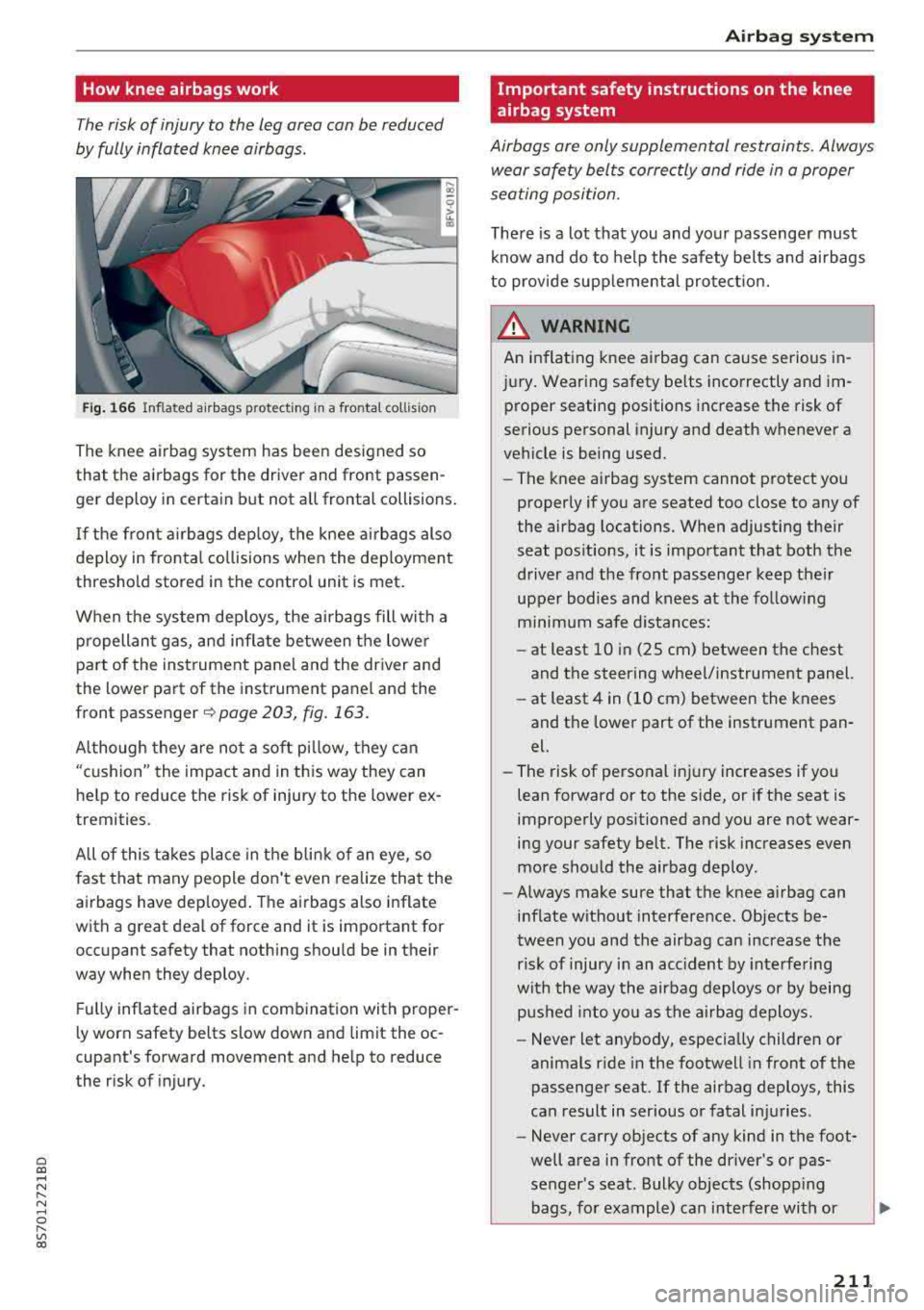
Cl co .... N ,....
N .... 0 ,....
Vl co
How knee airbags work
The risk of injury to the leg area can be reduced
by fully inflated knee airbags.
Fig. 166 Inflated airbags protecting in a frontal collision
The knee airbag system has been designed so
that the airbags for the driver and front passen
ger deploy in certain but not all frontal collisions.
If the front airbags deploy, the knee airbags also
deploy in frontal collisions when the deployment
threshold stored in the control unit is met.
When the system deploys, the airbags fill with a propellant gas, and inflate between the lower
part of the instrument panel and the driver and
the lower part of the instrument panel and the front
passenger ~ page 203, fig. 163.
Although they are not a soft pillow, they can
"cushion" the impact and in this way they can
help to reduce the risk of injury to the lower ex
tremities.
All of this takes place in the blink of an eye, so
fast that many people don't even realize that the
airbags have deployed. The airbags also inflate
with a great deal of force and it is important for
occupant safety that nothing should be in their
way when they deploy .
Fully inflated airbags in combination with proper
ly worn safety belts slow down and limit the oc
cupant 's forward movement and help to reduce
the risk of injury.
Airbag system
Important safety instructions on the knee
airbag system
Airbags are only supplemental restraints . Always
wear safety belts correctly and ride in a proper
seating position .
There is a lot that you and your passenger must
know and do to help the safety belts and airbags
to provide supplemental protection.
_& WARNING
-
An inflating knee airbag can cause serious in-
jury. Wearing safety belts incorrectly and im proper seating positions increase the risk of
serious personal injury and death whenever a
vehicle is being used.
-The knee airbag system cannot protect you properly if you are seated too close to any of
the airbag locations. When adjusting their
seat positions, it is important that both the
driver and the front passenger keep their
upper bodies and knees at the following minimum safe distances:
-at least 10 in (25 cm) between the chest
and the steering wheel/instrument panel.
-at least 4 in (10 cm) between the knees and the lower part of the instrument pan
el.
-The risk of personal injury increases if you
lean forward or to the side, or if the seat is
improperly positioned and you are not wear
ing your safety belt. The risk increases even
more should the airbag deploy .
- Always make sure that the knee airbag can
inflate without interference. Objects be
tween you and the airbag can increase the risk of injury in an accident by interfering
with the way the airbag deploys or by being pushed into you as the airbag deploys.
-Never let anybody, especially children or
animals ride in the footwell in front of the
passenger seat. If the airbag deploys, this
can result in serious or fatal injuries .
-Never carry objects of any kind in the foot
well area in front of the driver's or pas
senger's seat. Bulky objects (shopping bags, for example) can interfere with or
~
211
Page 214 of 310
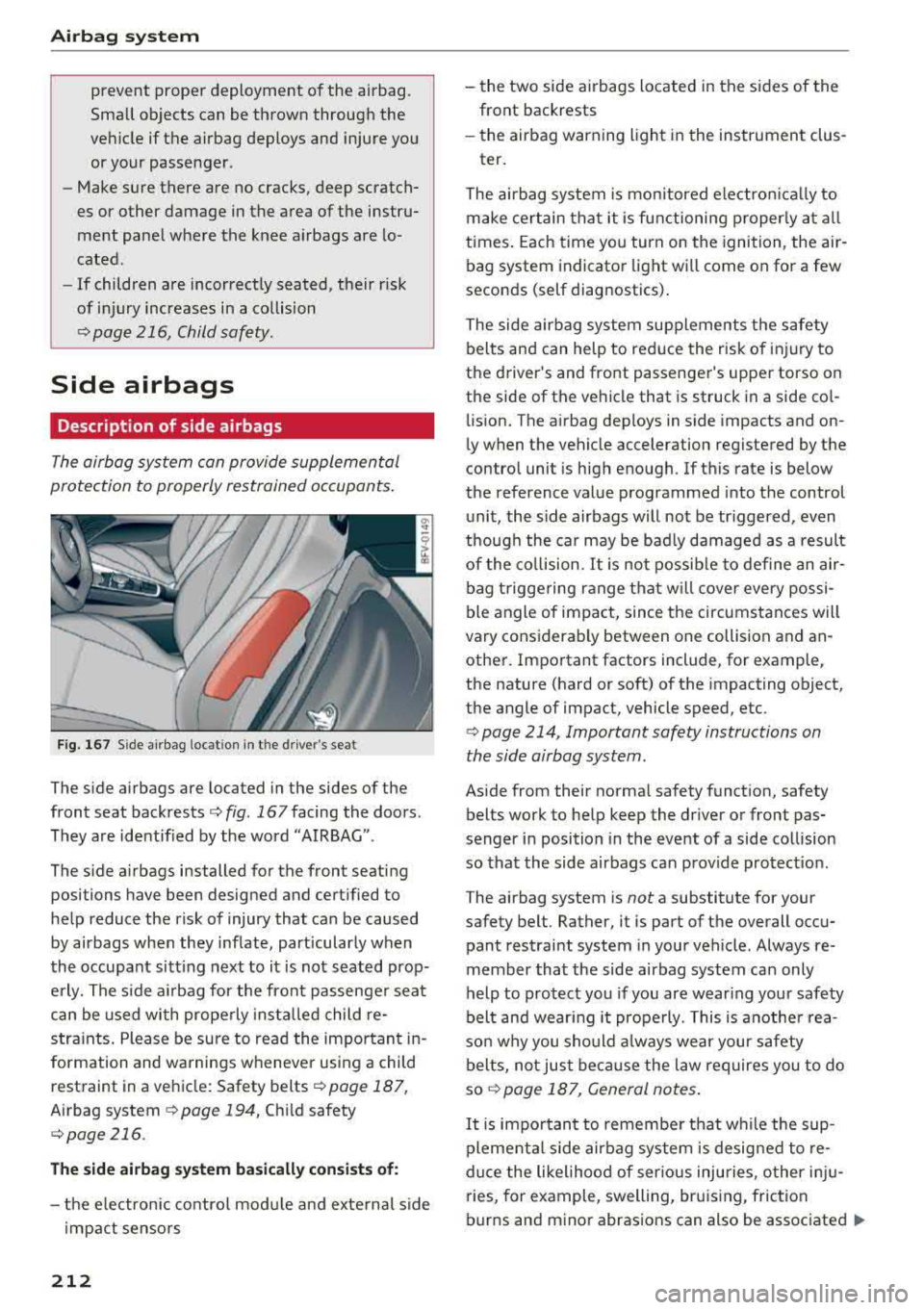
Airbag system
prevent proper deployment of the airbag.
Small objects can be thrown through the
vehicle if the airbag deploys and injure you
or your passenger .
- Make sure there are no cracks, deep scratch
es or other damage in the area of the instru
ment panel where the knee airbags are lo
cated.
- If children are incorrectly seated, their risk
of injury increases in a collision
c:> page 216, Child safety.
Side airbags
Description of side airbags
The airbag system can provide supplemental
protection to properly restrained occupants.
Fig. 167 Side airbag locat ion in t he drive r's se at
The side airbags are located in the sides of the
front seat backrests
c:> fig. 167 facing the doors .
They are identified by the word "AIRBAG".
The side airbags installed for the front seating
positions have been designed and certified to
help reduce the risk of injury that can be caused
by airbags when they inflate, particularly when
the occupant sitting next to it is not seated prop
erly. The side airbag for the front passenger seat
can be used with properly installed child re
straints. Please be sure to read the important in
formation and warnings whenever using a child
restraint in a vehicle: Safety belts
c:> page 187,
Airbag system c:>page 194, Child safety
c:> page 216 .
The side airbag system basically consists of:
-the electronic control module and externa l side
impact sensors
212
-the two side airbags located in the sides of the
front backrests
-the airbag warning light in the instrument clus-
ter.
The airbag system is mon itored electron ically to
make certain that it is functioni ng properly at all
times. Each time you turn on the ignition, the air
bag system indicator light will come on for a few
seconds (self diagnostics) .
The side airbag system supplements the safety
belts and can help to reduce the risk of injury to
the driver's and front passenger's upper torso on
the side of the vehicle that is struck in a side col
lision. The airbag deploys in side impacts and on
ly when the vehicle acceleration registered by the
control unit is high enough. If this rate is below
the reference value programmed into the control
unit, the side airbags will not be tr iggered, even
though the car may be badly damaged as a result
of the collision.
It is not possible to define an air
bag triggering range that w ill cover every possi
ble angle of impact, since the circumstances will
vary considerably between one collision and an
other. Important factors include, for example,
the nature (hard or soft) of the impacting object,
the angle of impact, vehicle speed, etc.
c:> page 214, Important safety instructions on
the side airbag system.
Aside from their normal safety function, safety
belts work to help keep the driver or front pas
senger in position in the event of a side collision
so that the side airbags can provide protection.
The airbag system is
not a substitute for your
safety belt. Rather, it is part of the overall occu
pant restraint system in your vehicle . Always re
member that the side airbag system can only
help to protect you if you are wear ing your safety
belt and wear ing it properly. This is another rea
son why you sho uld always wear your safety
belts, not just because the law requires you to do
so
c:> page 187, General notes.
It is impo rtant to remember that while the sup
plemental side airbag system is designed to re
duce the likelihood of ser ious injuries, other inju
ries, for example, swelling, bruising , friction
burns and minor abrasions can also be associated
...,
Page 215 of 310
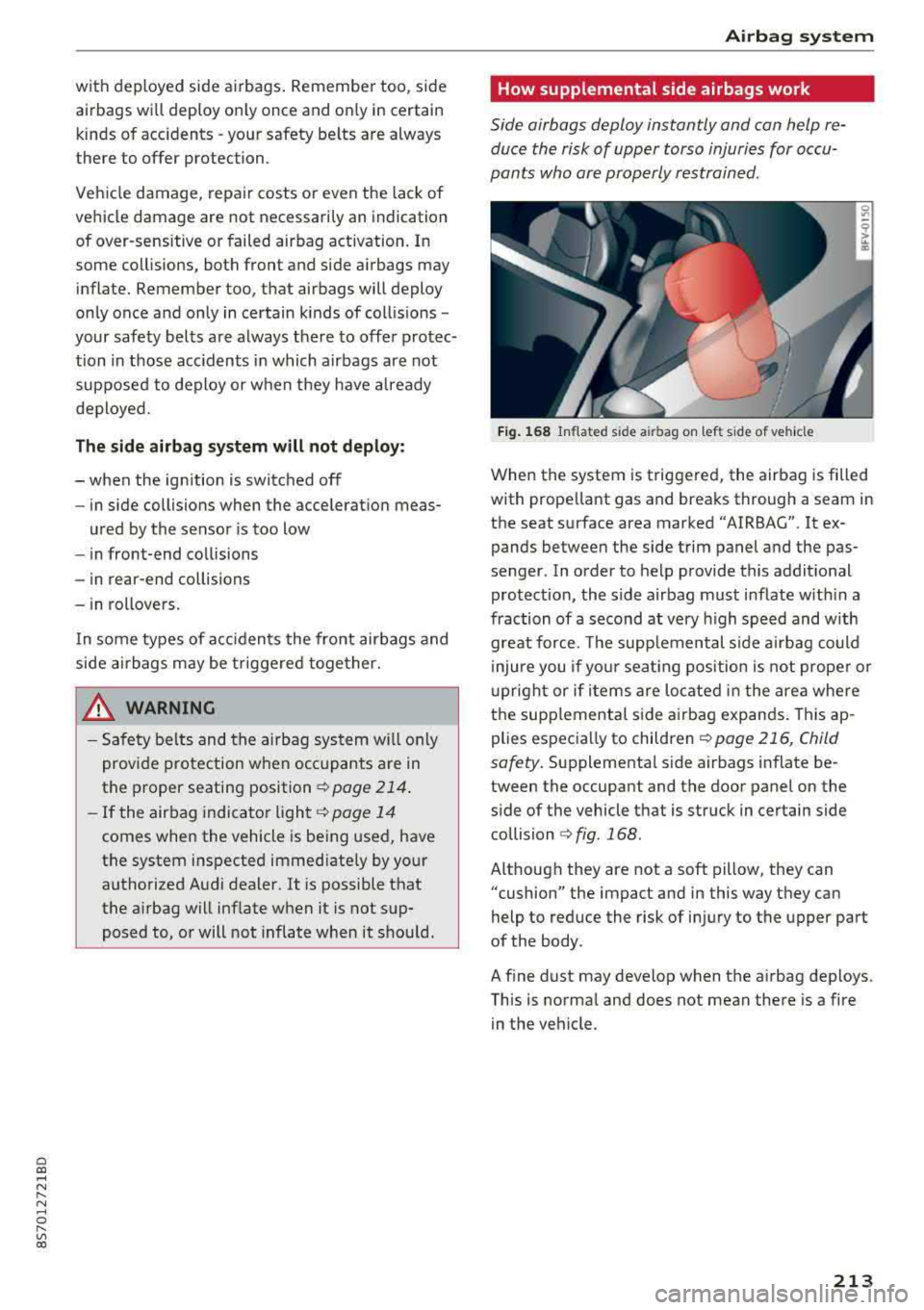
Cl co .... N ,....
N .... 0 ,....
Vl co
with deployed side airbags. Remember too, side
airbags wi ll deploy on ly once and on ly in certain
kinds of acc idents -your safety be lts are always
there to offer protection.
Vehicle damage, repair costs or even the lack of
ve hicle damage are not necessarily an indication
of over-sensitive or failed airbag act ivation. In
some collisions, both front and side a irbags may
inflate. Remember too, that airbags will deploy
only once and only in ce rtain kinds of coll is ions
-
your safety belts are always there to offer protec
tion in those acc idents in which airbags are not
supposed to deploy or when they have already
deployed.
The side airbag system will not deploy:
-when the ign ition is switched off
-in side collisions when the acceleration meas-
ured by the sensor is too low
-in front-end collisions
-in rear-end collisions
-in rollovers.
I n some types of accidents the front airbags and
side airbags may be triggered together.
_& WARNING
-Safety belts and the airbag system will only
provide protection when occupants are in
the proper seating position¢
page 214.
-If the airbag indicator light q page 14
comes when the vehicle is being used, have
the system inspected immed iate ly by your
authorized Audi dealer. It is possible that
the a irbag will inflate when it is not sup
posed to, or will not inflate when it should.
Airbag system
How supplemental side airbags work
Side airbags deploy instantly and can help re
duce the risk of upper torso injuries for occu
pants who are properly restrained.
Fig. 168 Inflated side airbag on left side of vehicle
When the system is triggered, the airbag is filled
with propellant gas and breaks through a seam in
the seat surface area marked "AIRBAG". It ex
pands between the side trim panel and the pas
senger . In order to help provide this addit ional
protect ion, the side airbag must inflate w ith in a
fraction of a second at very high speed and with
great force. The supplemental sid e a irbag could
injure you if you r seating position is not proper or
u pr ight or if items are located in the area where
the supp lemental side airbag expands . This ap
plies especially to children
¢ page 216, Child
safety.
Supplementa l side airbags inflate be
tween the occupant and the door panel on the
s ide of the vehicle that is struck in certain side
collision ¢
fig. 168.
Although they are not a soft pillow, they can
"cushion" the impact and in this way they can
help to reduce the risk of injury to the upper part
of the body .
A fine dust may develop when the airbag deploys.
This is normal and does not mean there is a fire
in the veh icle.
213
Page 216 of 310
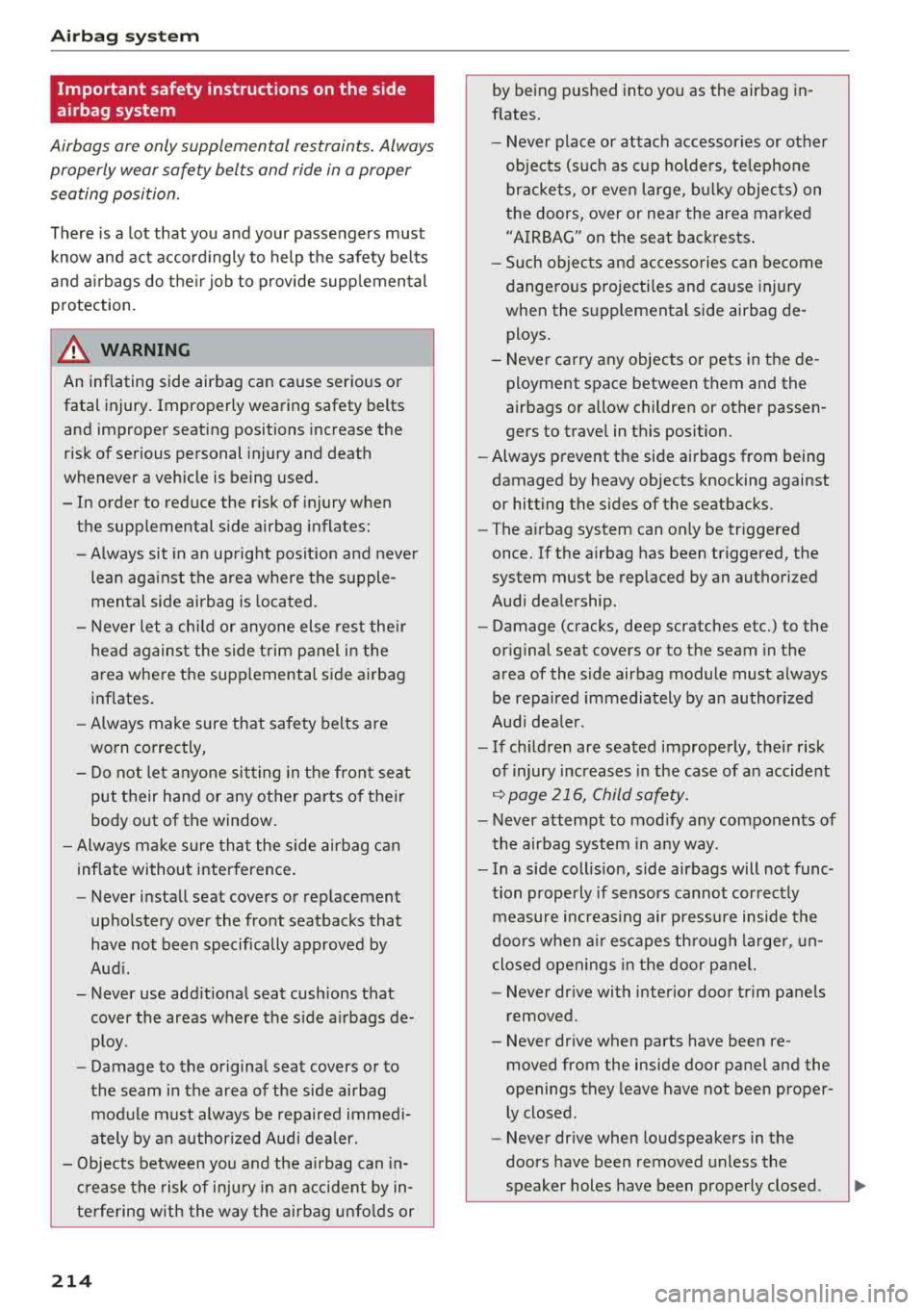
Airbag syste m
Important safety instructions on the side
airbag system
Airbags are only supplemental restraints. Always
p roperly wear safety belts and ride in a proper
seating position.
There is a lot that you and your passengers must
know and act accord ingly to help t he safety be lts
and a irbags do the ir job to provide supplemental
protection.
A WARNING
An inflating side airbag can cause serious or
fatal injury . Improperly wearing safety belts
and improper seating positions increase the
r isk of serious personal injury and death
whenever a vehicle is being used .
- In order to reduce the risk of injury when
the supplemental s ide airbag inflates:
- Always sit in an up right posit ion and never
lean ag ainst the area where the s upple
mental side airbag is located.
-
- Never let a chi ld or anyone else rest the ir
head agains t the side t rim p anel in the
area whe re the supp lemental s ide a irbag
inflates.
- Always make sure that safety belts are
worn correctly,
- Do not let anyone sitting in the fron t seat
put their hand or any other parts o f the ir
body out of the window .
- Always make sure tha t the side airbag can
inflate without inter ference.
- Never install seat covers or rep lacement
upho lstery over the front seatbacks that
have not been specifically approved by
Aud i.
- Never use add itiona l seat cushions that
cover the areas where the s ide airbags de
ploy .
- Damage to the origina l seat covers or to
the seam in the area of the side airbag
mod ule m ust always be repaired immed i
ately by an authorized Audi dealer.
- Objects between you and the airbag can in
cr ease t he risk of inju ry in an accident by in
te rfe ring w ith the way the airb ag unfo lds or
214 by being pushed
into you as the airbag in
flates .
- Never place or attach accessor ies or other
ob jects (s uch as cup ho lde rs, telephone
bracke ts, or even l arge, b ulk y objec ts) on
the doors, over or near the area mar ke d
"A IRBAG" on the seat backrests .
- Such objec ts and accessories can become
dange ro us projecti les and cause injury
when the supplemental side airbag de ploys.
- Never carry any objects or pets in the de
ployment space between them and the
airbags or allow children or other passen
gers to trave l in this position .
- Always prevent the side airbags from being
damaged by heavy objects knocking against
or hitting the sides of the seatbacks.
- The a irbag system can only be triggered
once . If the airbag has been triggered, the
system must be replaced by an authorized
Aud i dealership.
- Damage (cracks, deep scratches etc.) to the
or iginal seat covers or to the seam in the
area of the side airbag module must always
be repaired immediately by an authorized
Aud i dea le r.
- If ch ildren are seated imprope rly, thei r risk
of injury increases in the case of an accident
~ page 216, Child safety .
-Never attempt to mod ify any components of
the airbag system in any way.
- In a side collision, side airbags will not func
tion properly if sensors cannot correctly measure increasing air press ure inside the
doors when a ir e scapes th rough large r, un
closed openings in the door p anel.
- Never dr ive with interior door t rim panels
removed.
- Never dr ive when parts have been re
moved from the inside door panel and the
openings they leave have not been proper
ly closed .
- Never dr ive when loudspeakers in the
doors have been removed unless the
speaker holes have been properly closed .
Page 217 of 310
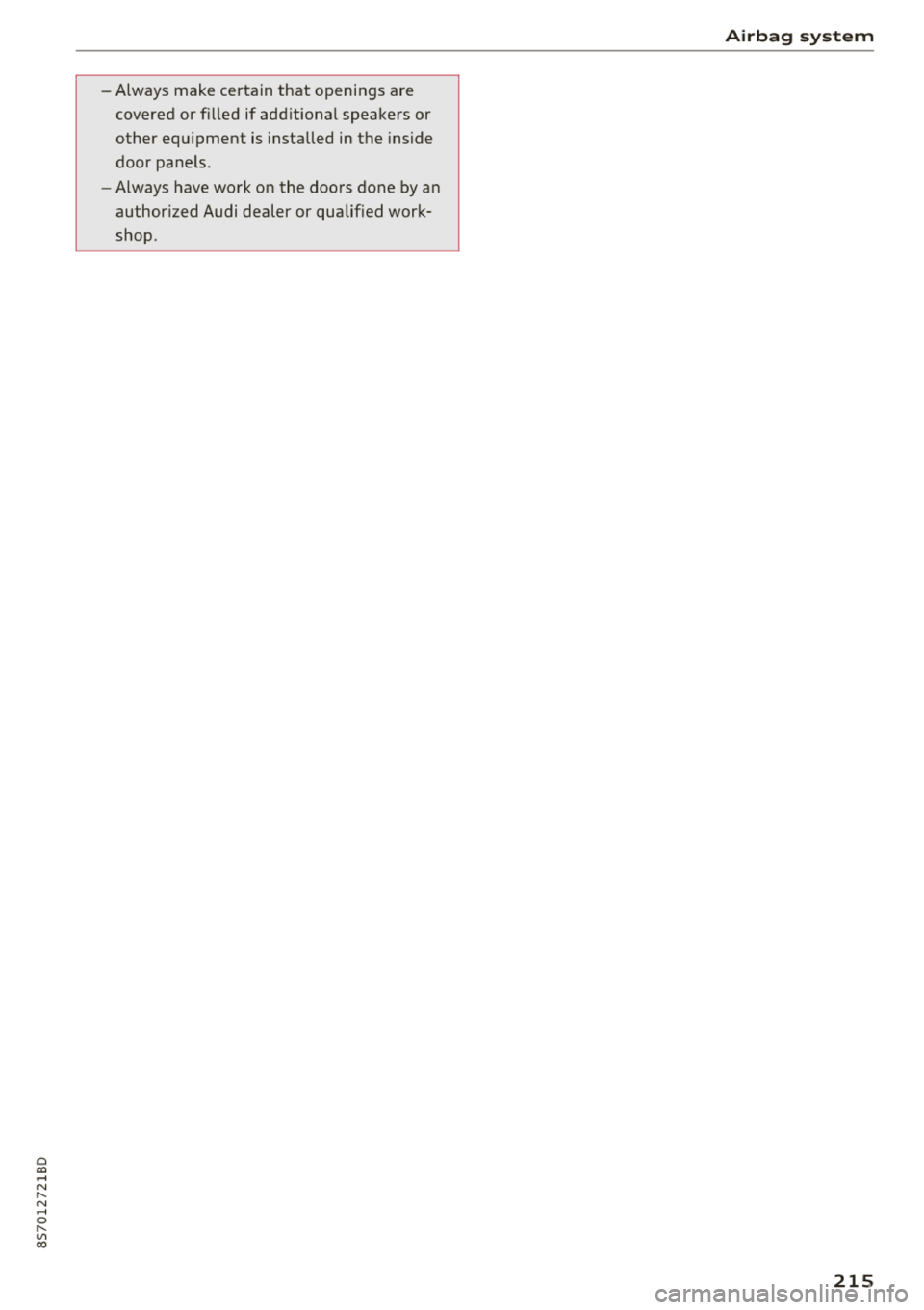
Cl 00 .-< N r-N .-< 0 r-Vl 00
-Always make certain that openings are
covered or f illed if add itiona l speakers or
other equ ipment is installed in the inside
door panels.
- Always have work on the doors done by an
author ized Audi dealer or qualified work
shop.
Airbag syste m
215
Page 218 of 310
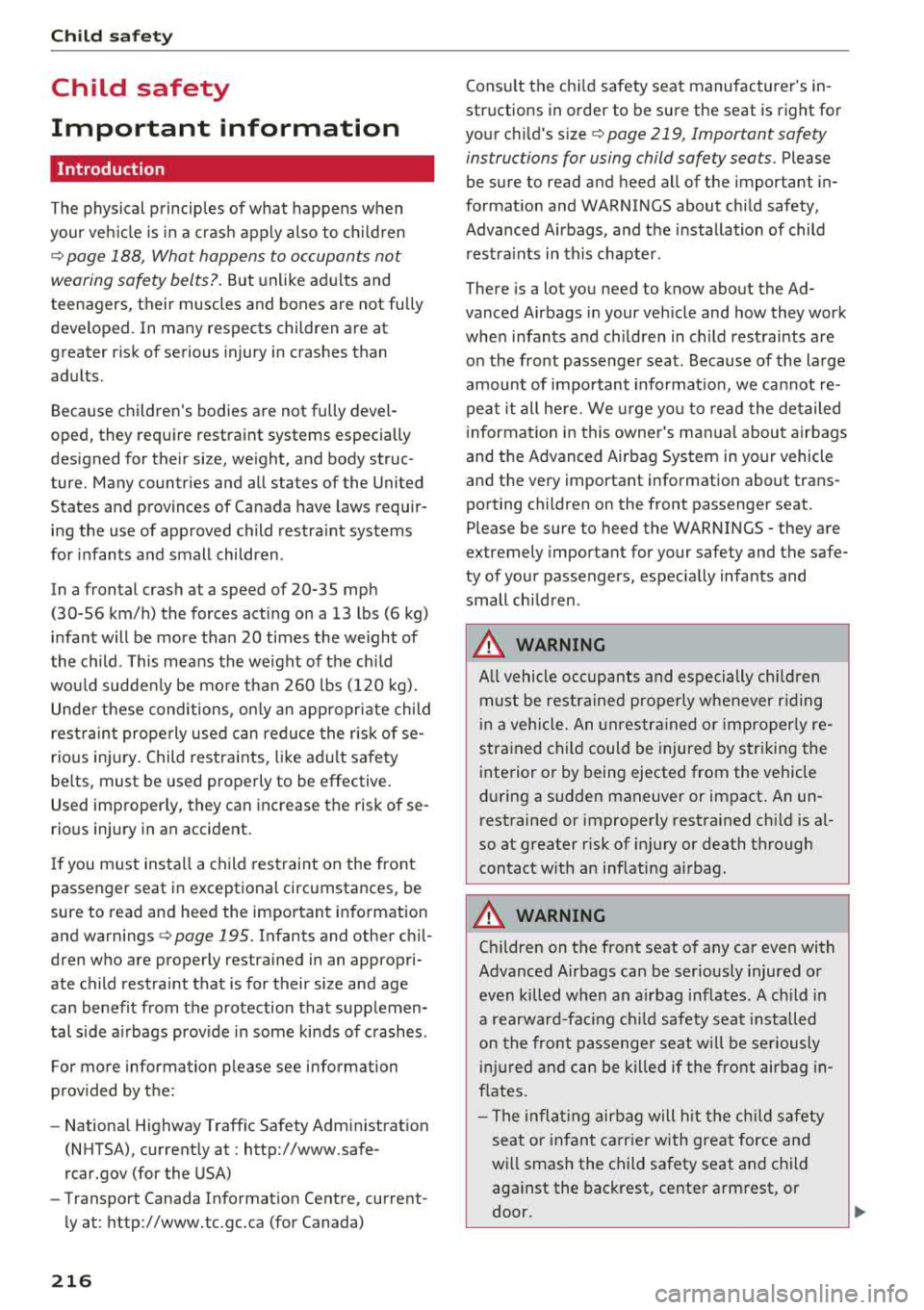
Child safety
Child safety
Important information
Introduction
The physical princip les of what happens when
your veh icle is in a cras h apply also to childr en
¢ page 188, What happens to occupants not
wearing safety belts?.
But unlike adults and
teenagers, their muscles and bones are not fully
developed. In many respects children are at
greater risk of serious injury in crashes than
adu lts.
Because children's bodies are not fu lly devel
oped, they require restraint systems especially
designed for their size, weight, and body struc
ture. Many countries and all states of the United
States and provinces of Canada have laws requir
ing the use of approved child restraint systems
for infants and small children .
In a frontal crash at a speed of 20-35 mph (30-56 km/h) the forces acting on a 13 lbs (6 kg)
infant will be more than 20 times the we ight of
the child . This means the weight of the child
wou ld suddenly be more than 260 lbs ( 120 k g).
Under th ese conditions, only an appropriate child
rest raint properly used can reduce the r isk of se
rio us injury. Child restraints, like adult safety
be lts, must be used properly to be effective.
Used improperly, they can increase the risk of se
rious inj ury in an accident.
If you must install a child restraint on the front
passenger seat in exceptional circumstances, be
sure to read and heed the important information
and warn ings
¢ page 195. Infants and other ch il
dren who are properly restrained in an appropri
ate child restraint that is for their size and age
can benefit from the protection that supplemen
tal side airbags provide in some kinds of crashes .
For more information please see information
provided by the:
- Nationa l Highway Traffic Safety Administration
(NHTSA), current ly at: http:/ /www .safe
rcar.gov (for the USA)
- Transport Canada Information Centre, current
ly at: http://www.tc .gc.ca (for Canada)
216
Consult the child safety seat manufacturer's in
structions in order to be sure the seat is right for
your ch ild's s ize
¢ page 219, Important safety
instructions for using child safety seats.
Please
be sure to read and heed all of the important in
format ion and WARNINGS about child safety,
Advanced Airbags, and the installation of child
restraints in this chapter.
There is a lot you need to know about the Ad
vanced Airbags in your veh icle and how they work
when infants and children in ch ild restraints are
on the front passenger seat . Because of the large
amount of impo rtant informat ion, we ca nnot re
peat it all he re. We urge you to read the detailed
inf ormation in this owner's manual about airbags
and the Advanced Airbag System in your vehicle
and the very important information about trans
porting children on the front passenger seat.
Please be sure to heed the WARNINGS
-they are
extremely important for your safety and the safe
ty of your passengers, especially infants and
small children .
.&_ WARNING
All vehicle occupants and especially child re n
must be restrained properly whenever riding
in a vehicle. An unrestrained or improperly re
stra ined child could be injured by striking the
interior or by being ejected from the vehicle
during a sudden maneuver or impact . An un
restrained or improperly restrained child is al
so at greater r isk of injury or death through
contact w ith an inflating airbag.
A WARNING
Children on the front seat of any car even with
Advanced Airbags can be seriously injured or
even killed when an airbag inflates. A ch ild in
a rearward-fac ing child safety seat installed
on the front passenger seat will be seriously
in ju red and can be killed if the front airbag in
flates.
- The inflat ing airbag will hit the child safety
seat or infa nt carrier with great force and
will smash the child safety seat and child
against the backrest, center armrest, or
door.
Page 219 of 310
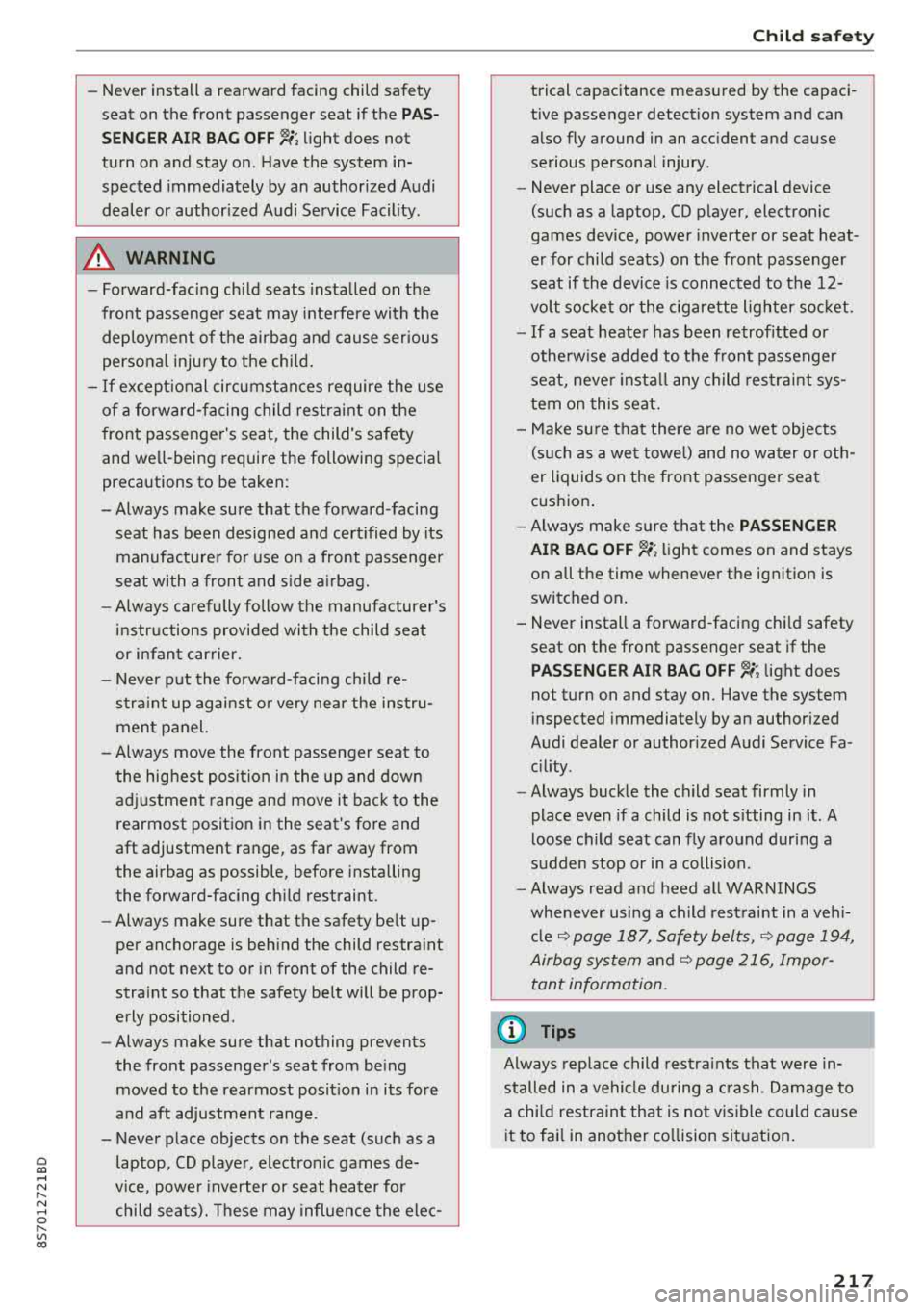
Cl 00 .-< N r-N .-< 0 r-Vl 00
-Never install a rearward facing child safety
seat on the front passenger seat if the
PA S·
SEN GER AIR B AG
OFF,;; light does not
turn on and stay on. Have the system in
spected immediately by an authorized Audi
dealer or author ized Audi Service Facility .
A WARNING
-Forward-fac ing ch ild seats insta lled on the
front passenge r seat may inte rfere with the
deployment of the a irbag and cause serious
persona l inju ry to the child .
- If except ional circumstances require the use
of a forward-facing child res traint on the
front passenger's seat, the child's safety
and well-being require the following special
precautions to be taken:
- Always make sure that the forward-facing seat has been designed and cert ified by its
manufacture r fo r u se on a front passenger
seat with a front and s ide a irb ag.
- Always carefully follow the manufacturer's
instr uctions provided with the child seat
or i nfan t ca rrier.
- Never p ut the fo rward-facing child re
s tra int up against o r very near the instru
men t panel.
- Always move the front passenger seat to
the highest posit ion in the up and down
ad justment range and move it back to the
rearmost position in the seat's fore and
aft adjustment range, as far away from
the airbag as possible, before installing
the forward-fac ing ch ild restraint.
- Always make sure that the safety be lt up
pe r anchorage is behind the child restra int
and not next to o r in front of the child re
stra int so that the safety belt will be prop
erly positioned.
- Always make sure that nothing prevents
the front passenger's seat from be ing
moved to the rearmost posit ion in its fore
and aft adjustment range .
- Never place objects on the seat (such as a
laptop, CD p laye r, electronic games de
vice, powe r inverter or seat heater for
child se ats). These m ay influence the ele c-
Ch ild saf ety
trical capacitance measu red by the capac i
tive passenger detection system and can also fly around in an acc ident and cause
serious personal injury .
- Never place or use any electrical device
(such as a laptop, CD player, electronic
games device, powe r inverter or seat heat
er for child seats) on the front passenger
seat if the device is connected to the 12-
vo lt socke t or the cigarette lighter so cket.
- If a seat heate r has been retrofitted or
othe rw ise added to t he front passenger
seat, neve r insta ll any child res traint sys
tem on this seat.
- Make su re that there a re no wet objects
(s uch as a we t towe l) and no w ater or oth
er liquids on the front passenger seat
cushion .
- Always make sure tha t the
PASSENGER
AIR BAG
OFF ,;; light comes on and stays
on all the time whenever the ignition is
switched on .
- Never install a forward -facing chi ld safety
seat on the front passenger seat if the
PASSENGER AIR BAG OFF ~; light does
not turn on and stay on. Have the system
inspected immediately by an author ized
Audi dealer or authorized Audi Service Fa
c ility .
- Always buck le the child seat firmly in
place even if a child is not s itting in it . A
loose child seat can fly aro und during a
sudden stop or in a collision.
- Always read and heed all WARNINGS
whenever using a child rest raint in a vehi
cl e
~page 187, Safety bel ts, ~page 194,
Airbag sy stem
and ~ page 216, Impor
tant information.
(D Tips
A lways replace child restraints that were in
stalled in a vehicle du ring a c rash . Damage to
a child restrain t that is not v is ible could cause
i t to fai l in another co llision sit uat ion .
217
Page 220 of 310
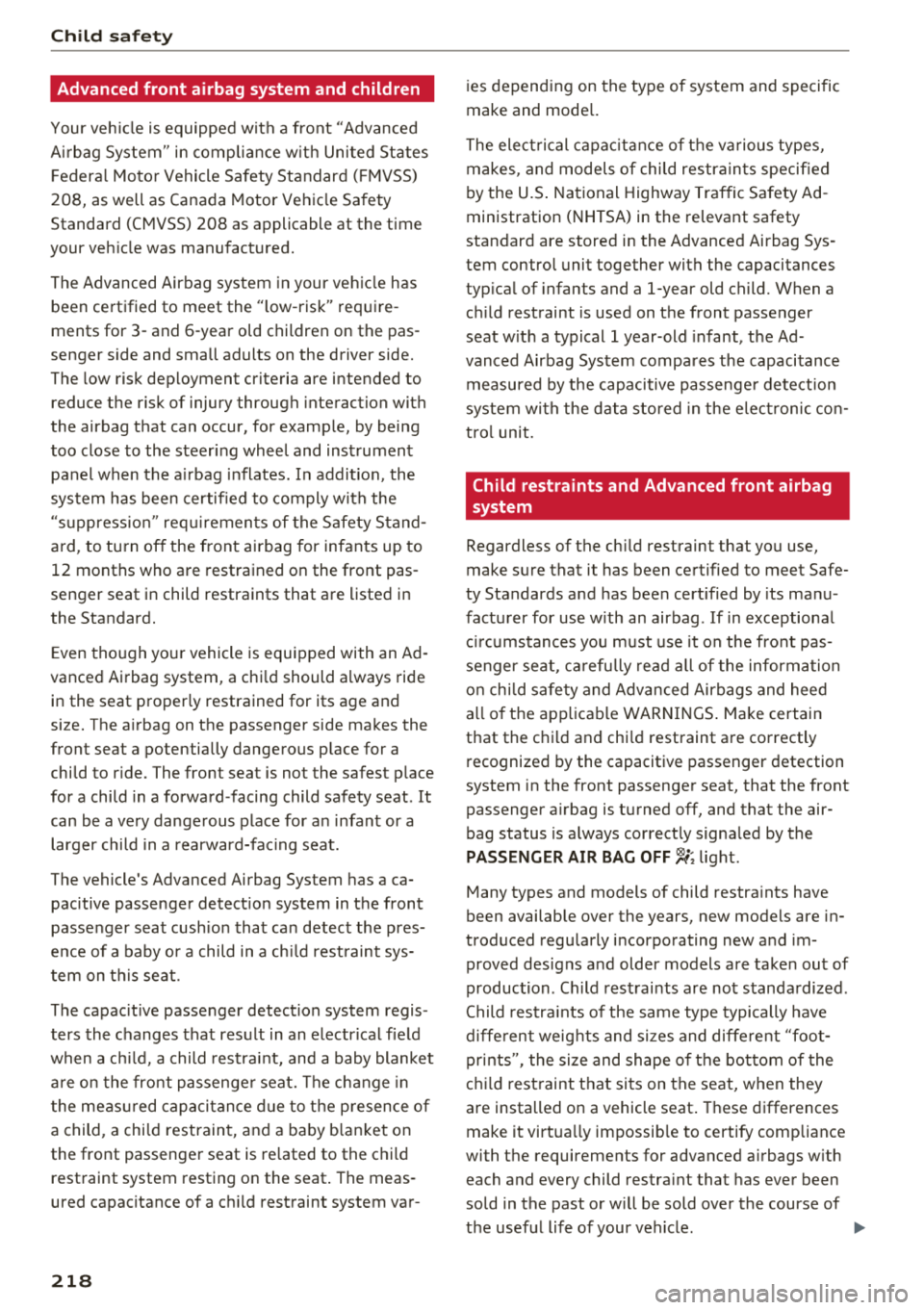
Child sa fety
Advanced front airbag system and children
Your veh icle is equipped w ith a front "Advanced
A irbag System" in comp liance w it h United States
F edera l Motor Vehicle Safety Standard ( FMVSS)
208, as well as Canada Motor Vehicle Safety
Standard (CMVSS) 208 as applicable at the time
your vehicle was manufactured.
The Advanced Airbag system in your veh icle has
been certified to meet the " low-risk" require
ments for 3- and 6-year old children on the pas
senger side and small adults on the driver side.
The low risk deployment criteria are intended to
reduce the risk of injury through interaction with
the airbag that can occur, for example, by being
too close to the steering wheel and instrument
panel when the a irbag inflates. In addit ion, the
system has been certified to comply w ith the
" su ppress io n" req uirements of the Safety S tand
ard, to tu rn off the front airbag for infants up to
12 months who are restrained on the front pas
senger seat in child restraints that are listed in
the Standard.
E ven tho ugh yo ur vehicle is equipped with an
Ad a
vanced Airbag system, a chi ld should a lways ride
in the seat proper ly restrained for its age and
size. The airbag on the passenger side makes the
front seat a potentially dangerous p lace for a
child to r ide . The front seat is not the safest place
for a child in a forward-facing child safety seat .
It
can be a very dange rous place for a n infant or a
larger child in a rearward-fac ing seat.
The vehicle's Advanced Airbag System has a ca
pac itive passenger detect ion system in the front
passenger seat cush ion that ca n detect the pres
ence of a baby or a child in a ch ild restraint sys
tem on t his seat .
The capac it ive passenger detect ion system regis
ters the changes that result in an electr ical field
when a c hild, a child restra int, and a baby blanket
a re on the front passenge r seat. The change in
t he meas ured capacitance due to t he p resence o f
a child, a chi ld restraint, and a baby b lanket on
the front passenger seat is re lated to the chi ld
restraint system resting on the seat . The meas
ured capacitance of a ch ild restraint system var-
218
ies depending on the type of system and specific
make and mode l.
The elect rical capac ita nce of the va rious types,
makes, and models of child restra in ts speci fied
by the U.S . National Highway Tra ffic Safety Ad
ministration (NHTSA) in the relevant safety
standard are stored in the Advanced Airbag Sys
tem control unit together with the capacitances
typ ica l of infants and a 1-year old child. When a
c hi ld restraint is used on the front passenger
seat w it h a typical 1 year-old infant, t he Ad
vanced Airbag System compares the capacitance measured by the capacitive passenge r detect ion
system wi th the data stored in the e lec tronic co n
tro l unit .
Child restraints and Advanced front airbag
system
Regardless of the ch ild restraint that you use,
make sure that it has been certified to meet Safe
ty Standards and has been cert ified by its manu
factu rer for use w ith an airbag . If in exceptional
c ir cumstances you m ust use it on the front pas
senger seat, ca refully read all of the information
o n chi ld safety and Advanced Airbags and heed
a ll of th e app licab le WARNINGS . Make certain
that the chi ld and chi ld restraint are correctly
recognized by the capacitive passenger detection
system in the front passenger seat, that the front passenger a irbag is turned off, and that the air
bag status is always correct ly signa led by the
PASSENGER AIR BAG OFF ~; light.
Many types and models of child restra ints have
been available over the years, new models are in
troduced regularly incorporating new and im
proved designs and older models are taken out of
production . Ch ild rest rai nts are not standa rdized .
Child res tra ints of the same type typically have
d iffe rent weights and sizes and diffe re nt "foot
pr ints", the size and shape o f th e bo ttom of the
ch ild restraint that sits on the seat, w hen they
are installed on a vehicle seat . These differences
make it virtua lly impossib le to certify comp liance
with the requirements for advanced a irbags w ith
each and every child restra int that has ever been
sold in the past or will be sold over the course of
the useful life of your veh icle .
.,.